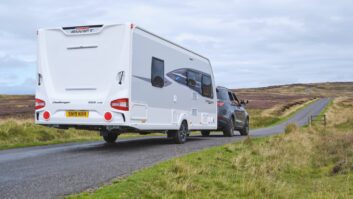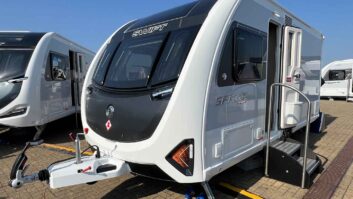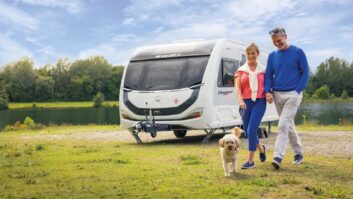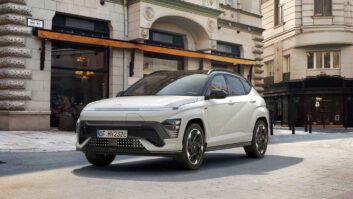Swift is the UK’s largest manufacturer of touring caravans, and 2024 marks the brand’s 60th year in the business. In addition, it has also been producing motorhomes since 1985 and holiday homes since 2005, so next year will see two more milestones for the group.
As a result, it’s not surprising to see the brand regularly feature at the Practical Caravan Awards, where the best caravans are picked out, winning two categories at our most recent awards.
Nowadays, it is common to see tourers from the brand, such as the Swift Elegance Grande 760 or the Swift Challenger 560 SE, when pitched up at a campsite. However, Swift’s story isn’t one of being an overnight success – instead, it’s been a case of sheer hard graft and determination to ride out the storms the caravan industry has endured over the years and become one of the leading makes of caravans in the industry.
Like many high-achieving businesses, Swift began with just one person – Ken Smith – who had a brilliant idea and the acumen to bring it to fruition.

In the 1960s, caravan holidays were booming and manufacturers of tourers and static caravans were appearing almost at a weekly rate. Many of these would fail soon after start-up, while others enjoyed initial success, only to fold in one of the market downturns that cropped up over the years.
Manufacturing hub
Many of these new businesses were based in Hull and the surrounding areas of East Yorkshire. Names such as Ace, A-Line, Astral, Buccaneer, Mardon, Minster, Silverline and Swift began to make their mark on the scene, making many types of caravan as Hull became the centre of UK caravan manufacturing.
Hull benefited from its thriving docks, so important for importing timber and other materials and for exporting finished caravans. The region also had a hugely skilled workforce.
Back then, Ken Smith and his wife, Joan, ran a small business, hiring out washing machines. Using his skills in working with sheet metal and wood, they also produced sheds and greenhouses.

In the summer of 1964, Ken came across a small workshop where Ken Day was busy making a 3.5m-long four-berth caravan. Ken Day worked briefly for Ace Caravans (a brand purchased by Swift many years later), which began production in 1962.
The two Kens partnered up, but when Day decided to move on, Smith completed the first caravan, naming it Swift, and by the end of 1964 two other models had been added. Eventually, Ken and Joan, with the help of their son Peter, found that interest in the Swift caravan began to take off.

There followed factory extensions and the increase of the small staff team to more than eight people. At that stage, Ken would deliver the caravans to dealerships on his so-called days off!
Attending London’s Earl’s Court Caravan Show helped to win the business growing numbers of sales and by the 1970s, the brand had a firm following.
Next generation
Sadly, Ken Smith passed away in 1972. Peter and Joan took over the company and even tough times in the mid-1970s couldn’t prevent Swift from expanding.
By then based at premises in Dunswell Road, Cottingham (where the firm remains to this day), Peter steered Swift to become a top brand with groundbreaking designs.
The 1990s saw Swift grow even further, acquiring famous names such as Bessacarr, Cotswold, Eccles, Europa and Sprite as part of what was now the Swift Group.
Following further acquisitions, by the 2000s, Swift had become the largest UK caravan manufacturer, with investments in infrastructure and personnel securing the latest production techniques.

Today, Swift’s output encompasses touring caravans, campers, motorhomes, holiday homes and the innovative S-pod. The factory complex covers 45 acres and has its own access road, as well as the main entrance off Dunswell Road. Now employing 1300 people, the company also has a state-of-the-art staff café, Hub Sixty-Four, a reference to Swift’s first appearance in 1964 and decorated with images of the company’s long heritage.
We were recently given a tour of this massive complex, where a new extension had been completed for manufacturing holiday lodges. We saw the motorhome assembly lines, as well as the campervans division – these are made on site but kept separate from the main factories.
The touring caravan line is fed with components from various parts of the factory, starting with the chassis and the floors – all controlled from a main office to ensure that every item is in the right place at the right time.

Furniture suppliers deliver the furniture for the next batch of Sprites, such as the new Swift Sprite Exclusive Quattro MB, Challengers and so on, depending what’s on the line.
Large gangways allow the workforce to operate in a spacious, clean environment and for parts such as sides and floors to be manoeuvred onto the main line.
We also saw the separate section of the factory that produces Basecamps, such as the Swift Basecamp 3, while Swift tourers follow the main production line. The amount of work that goes into producing any caravan is simply amazing, especially with all the modern plumbing and wiring systems now being installed.

Swift uses GRP panels and unlike other brands, it manufactures its own in a separate building on the factory site. This allows for the strictest quality control.
We watched as two lines were producing Elegance and Challenger models. Modern equipment helps to ensure the highest possible accuracy in installing fittings, and Swift is constantly investing in the latest machinery to maintain its position at the leading edge of caravan manufacture.
The high standards extend to staff performance, too, with everybody working in the factory receiving Swift training.
Constant activity
The production line is organised to ensure constant workflows through to completion, when the vans get final inspections before being wheeled out to the dispatch area.
It’s quite a while since Swift first opened its doors to the public for factory tours, but they proved popular with customers. It is interesting to see the latest developments in production and design.

Would we be let into new model secrets? No, lips were sealed – but we can certainly say that from the very first tourer in 1964, the brand has evolved into a respected name throughout the UK and Europe.
The Swift premises are impressive and work continues to expand the factory, for example with a new showground for the holiday homes and S-pods – Swift has never stood still in all of its 60 years!
Are you thinking of purchasing a new tourer for the 2025 season? Then it’s important to make sure you consider a few key points to help you with buying a caravan that’s just right for you, as our experts explain.
If you’ve enjoyed reading this article, why not get the latest news, reviews and features delivered direct to your door or inbox every month. Take advantage of our brilliant Practical Caravan magazine SUBSCRIBERS’ OFFER and SIGN UP TO OUR NEWSLETTER for regular weekly updates on all things caravan related.





























